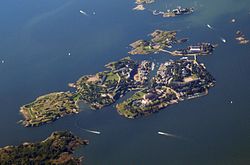Suomenlinna
| Suomenlinna Sveaborg |
|
|---|---|

An aerial view of Suomenlinna.
|
|
| Location | Helsinki, Finland |
| Coordinates | 60°08′37″N 24°59′04″E / 60.14361°N 24.98444°ECoordinates: 60°08′37″N 24°59′04″E / 60.14361°N 24.98444°E |
| Official name: Fortress of Suomenlinna | |
| Type | Cultural |
| Criteria | iv |
| Designated | 1991 (15th session) |
| Reference no. | 583 |
| State Party | Finland |
| Region | Europe and North America |
Suomenlinna (Finnish) or Sveaborg (Swedish), until 1918 Viapori (Finnish), is an inhabited sea fortress built on six islands (Kustaanmiekka, Susisaari, Iso-Mustasaari, Pikku-Mustasaari, Länsi-Mustasaari and Långören) and which now forms part of the city of Helsinki, the capital of Finland.
Suomenlinna is a UNESCO World Heritage site and popular with tourists and locals, who enjoy it as a picturesque picnic site. Originally named Sveaborg (Fortress of Svea), or Viapori as called by Finnish-speaking Finns, it was renamed in Finnish to Suomenlinna (Castle of Finland) in 1918 for patriotic and nationalistic reasons, though it is still known by its original name in Sweden and by Swedish-speaking Finns.
The Swedish crown commenced the construction of the fortress in 1748 as protection against Russian expansionism. The general responsibility for the fortification work was given to Augustin Ehrensvärd. The original plan of the bastion fortress was strongly influenced by the ideas of Vauban, the foremost military engineer of the time, and the principles of star fort style of fortification, albeit adapted to a group of rocky islands.
In addition to the island fortress itself, seafacing fortifications on the mainland would ensure that an enemy would not acquire a beach-head from which to stage attacks. The plan was also to stock munitions for the whole Finnish contingent of the Swedish Army and Royal Swedish Navy there. In the Finnish War the fortress surrendered to Russia on May 3, 1808, paving the way for the occupation of Finland by Russian forces in 1809.
...
Wikipedia
